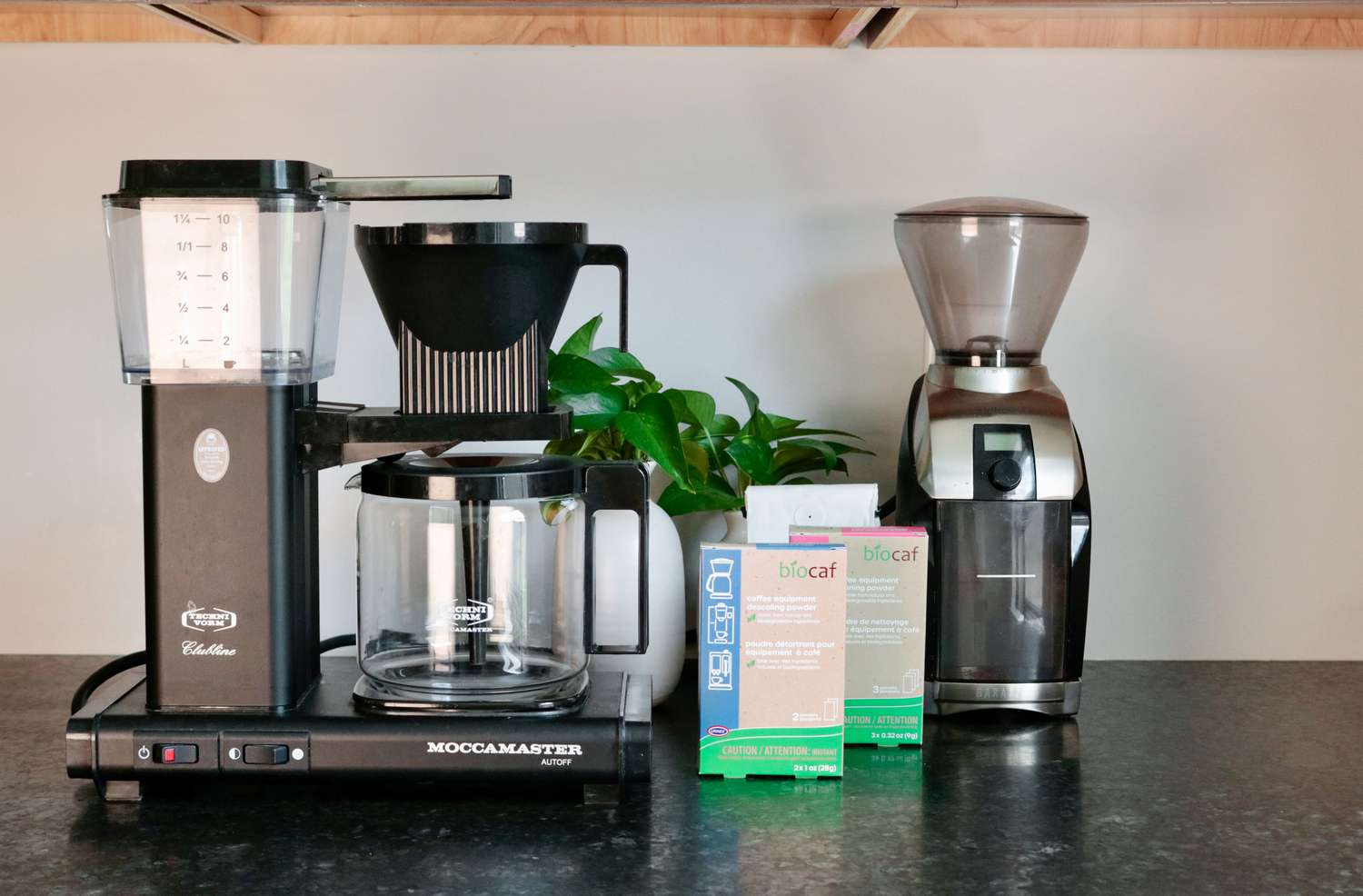Looking to keep your espresso machine running smoothly and producing delicious cups of coffee? Well, look no further! In this article, we will explore the best method for descaling an espresso machine to ensure it continues to function optimally. Descaling is an essential maintenance step that removes mineral buildup and ensures your machine’s components are free from any blockages that could affect the quality of your brews. Follow our simple guide to keep your espresso machine in top condition and enjoy consistently superb coffee every time.
Choosing the Right Descaling Solution
Understanding the Importance of Descaling
When it comes to maintaining the performance and longevity of your espresso machine, descaling is an essential task that should not be overlooked. Over time, mineral deposits such as limescale can accumulate in the internals of your machine, affecting its overall efficiency and taste of your espresso. Descaling is the process of removing these deposits and ensuring that your machine continues to operate at its best.
Different Types of Descaling Solutions
There are several different types of descaling solutions available in the market, each specifically designed to tackle different types of mineral deposits. The most common types of descaling solutions include citric acid, vinegar solution, and lemon juice descalers. It is important to choose a descaling solution that is compatible with your espresso machine and suitable for the type of mineral deposits you are dealing with.
Considerations when Choosing Descaling Solution
When choosing a descaling solution, there are a few important factors to consider. Firstly, consider the type of mineral deposits you are dealing with. If you have hard water with high mineral content, a stronger descaling solution may be required. Additionally, ensure that the descaling solution is non-toxic and safe for use in your machine. It is also worth checking the manufacturer’s recommendations and guidelines for descaling to ensure that you are using a solution that will not damage your machine.
Preparation for Descaling
Gathering the Necessary Supplies
Before starting the descaling process, it is important to gather all the necessary supplies. This includes the descaling solution, a clean cloth or sponge, a bowl or container for mixing the solution, and a brush or toothbrush for scrubbing removable parts. Having everything prepared and within reach will make the descaling process smoother and more efficient.
Reading the Espresso Machine Manual
To ensure that you are following the correct descaling procedure for your specific espresso machine, it is essential to read the machine’s manual. The manual will provide you with step-by-step instructions on how to prepare the machine for descaling and how to perform the descaling process itself. It may also contain specific recommendations or restrictions regarding descaling solutions and methods.
Cleaning the Removable Parts
Before starting the descaling process, it is important to clean any removable parts of the espresso machine. This includes the portafilter, brew group, and steam wand. Cleaning these parts beforehand will ensure that any loose debris or coffee residue does not interfere with the descaling process. Use warm, soapy water and a brush or toothbrush to thoroughly clean these components, then rinse them well and set them aside to dry.
Steps to Descaling an Espresso Machine
Preparing the Descaling Solution
Once you have gathered the necessary supplies and cleaned the removable parts, you can proceed with preparing the descaling solution. Follow the instructions provided with the descaling solution to mix the appropriate amount with water in a bowl or container. Be sure to use the correct ratio of solution to water as specified by the manufacturer. Mix the solution until it is fully dissolved and ready to use.
Purging the Espresso Machine
Before running the descaling solution through your espresso machine, it is important to purge the machine. This involves flushing hot water through the system to remove any loose debris or residue. To do this, simply turn on the machine and allow it to heat up. Once hot, run a small amount of hot water through the brew group and steam wand to clear any debris.
Running the Descaling Solution through the Machine
With the machine purged, it is time to run the descaling solution through the espresso machine. Follow the manufacturer’s instructions on your machine’s manual for the specific steps on this process. Generally, this involves filling the water reservoir with the descaling solution and running it through the machine as if you were making a cup of espresso. Be sure to collect the descaling solution that comes out of the machine for proper disposal.
Cleaning the Espresso Machine Components
Cleaning the Brew Group
The brew group is one of the most important components of an espresso machine and requires regular cleaning to maintain optimal performance. After descaling, remove the brew group from the machine and use a brush or toothbrush to gently scrub away any remaining residue or scale buildup. Be careful not to use excessive force and avoid using abrasive cleaners that could damage the brew group. Rinse the brew group thoroughly and allow it to dry before reassembling.
Descaling the Portafilter
The portafilter is another crucial component that should be cleaned and descaled regularly. After descaling, remove the filter basket from the portafilter and scrub it gently with a brush or toothbrush. Pay close attention to any areas where scale buildup may be present. Rinse the portafilter and filter basket thoroughly and dry them before reassembly.
Descaling the Steam Wand
The steam wand is susceptible to mineral deposits due to its constant exposure to steam and hot water. After descaling, remove the steam wand tip and soak it in the descaling solution for a few minutes. Use a brush or toothbrush to scrub away any stubborn scale buildup. Rinse the steam wand thoroughly and reattach the steam wand tip.
Rinsing and Reassembling
Rinsing the Espresso Machine
After the descaling process is complete, it is essential to thoroughly rinse the espresso machine to remove any traces of the descaling solution. Fill the water reservoir with clean, filtered water and run it through the machine several times. This will help remove any remaining residue and ensure that your machine is ready for use.
Reassembling the Machine
Once the machine has been rinsed and all the removable parts have been cleaned and dried, it is time to reassemble the espresso machine. Follow the manufacturer’s instructions and guidelines to ensure that each component is properly fitted and secured. Take care not to force any parts or overtighten any screws, as this could potentially damage the machine.
Performing a Flush Brew
To ensure that the espresso machine is fully flushed and ready for use, it is recommended to perform a flush brew. This involves running a small amount of water through the machine without any coffee or descaling solution. The purpose of a flush brew is to ensure that there are no residual tastes or odors from the descaling process.
Regular Maintenance and Preventive Measures
Frequency of Descaling
The frequency of descaling will depend on several factors, such as the hardness of the water in your area and how often you use your espresso machine. Generally, it is recommended to descale your machine every 1-3 months. However, it is important to refer to your machine’s manual for specific guidelines and recommendations.
Cleaning the Water Reservoir
In addition to descaling, it is essential to regularly clean the water reservoir of your espresso machine. This will prevent any buildup of bacteria or mold, ensuring that your water remains clean and fresh. Clean the water reservoir by emptying any remaining water, then wash it with warm, soapy water. Rinse thoroughly and allow it to dry before refilling.
Using Filtered Water
Using filtered water instead of tap water can significantly reduce the occurrence of mineral deposits in your espresso machine. Consider investing in a water filter or using bottled water specifically designed for coffee and espresso machines. This will not only improve the taste of your espresso but also reduce the frequency of descaling.
Troubleshooting Descaling Issues
Removing Stubborn Scale Build-up
If you encounter stubborn scale build-up that is resistant to descaling, there are a few additional steps you can take. Firstly, try using a stronger descaling solution or increase the concentration of the solution. Let the solution soak for a longer period of time to allow it to break down the scale. If the issue persists, consider seeking professional assistance or contacting the manufacturer’s customer support for further guidance.
Dealing with Residual Descaling Solution
Sometimes, after completing the descaling process, there may still be traces of descaling solution present in the machine. To remove any residual solution, run several cycles of clean, filtered water through the machine. This will help flush out any remaining descaling solution and ensure that your machine is ready for use.
Contacting Customer Support
If you encounter any difficulties or have specific questions or concerns about the descaling process, do not hesitate to contact the customer support of your espresso machine’s manufacturer. They will be able to provide you with expert guidance, troubleshooting tips, and any additional information you may need.
Alternative Natural Descaling Methods
Using Vinegar Solution
A popular and readily available alternative to commercial descaling solutions is a vinegar solution. Mixing equal parts white vinegar and water can effectively break down mineral deposits in your espresso machine. However, it is important to note that the strong smell of vinegar may linger in the machine even after rinsing, which can potentially affect the taste of your coffee.
Lemon Juice Descaling
Another natural descaling method is using lemon juice. Lemon juice contains citric acid, which is effective in removing limescale. Mix equal parts lemon juice and water and follow the same descaling process as with commercial descaling solutions. Lemon juice not only helps remove mineral deposits but also leaves a pleasant citrus fragrance.
Citric Acid Solution
Citric acid is a commonly used descaling agent due to its high effectiveness in breaking down mineral deposits. You can purchase citric acid powder from specialty stores or online. Follow the instructions provided with the citric acid product to mix the appropriate amount with water. Use the solution in the same way as commercial descaling solutions.
Professional Descaling Services
When to Consider Professional Descale
While regular descaling can be done at home, there may be instances where it is more appropriate to seek professional descaling services. If you are unsure about how to properly descale your machine, or if you are facing stubborn scale build-up that you are unable to remove, it is recommended to consult with professionals who specialize in espresso machine maintenance.
Finding a Reliable Service Provider
When selecting a professional descaling service, it is important to choose a reliable and experienced provider. Look for companies that specialize in espresso machine maintenance and have a good reputation in the industry. Reading customer reviews and seeking recommendations from fellow espresso enthusiasts can help you find a trustworthy service provider.
Costs and Benefits of Professional Descale
While professional descaling services may come at an additional cost, they offer several benefits. Professionals have the expertise and knowledge to effectively descale your machine, ensuring that it is thoroughly cleaned and running at its best. Additionally, professional descaling services can save you time and effort, allowing you to enjoy your espresso with peace of mind.
Conclusion
Regular descaling is crucial for maintaining the performance, taste, and longevity of your espresso machine. By understanding the importance of descaling, choosing the right descaling solution, and properly preparing and cleaning the machine, you can ensure that your espresso machine continues to deliver delicious coffee for years to come. Remember to follow the manufacturer’s guidelines and recommendations, and don’t hesitate to seek professional assistance if needed. Choose the best method for your espresso machine and enjoy the perfect cup of espresso every time.









































